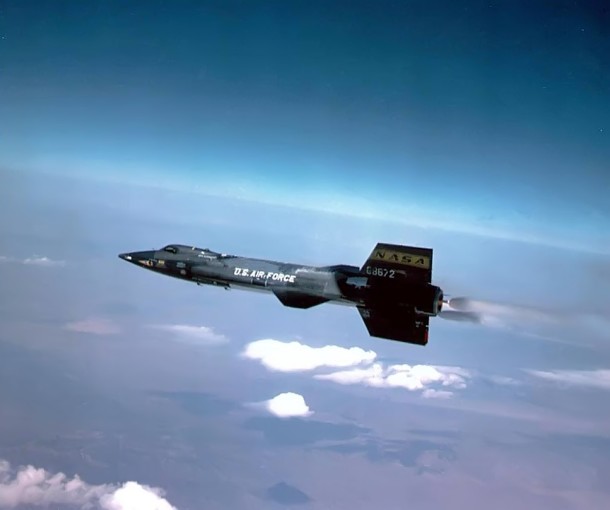
Forty-eight years ago this month, the No. 3 USAF/North American X-15 research aircraft broke-up during a steep dive from an apogee of 266,000 feet. The pilot, USAF Major Michael J. Adams, perished when his aircraft was ripped apart by aerodynamic forces as it passed through 65,000 feet at more than 2,500 mph.
The hypersonic X-15 was arguably the most productive X-Plane of all time. Between 1959 and 1968, a trio of X-15 aircraft were flown by a dozen pilots for a total of 199 official flight research missions. Along the way, the fabled X-15 established manned aircraft records for speed (4,534 mph; Mach 6.72) and altitude (354,200 feet).
The X-15 was a rocket, aircraft and spacecraft all rolled into one. Burning anhydrous ammonia and liquid oxygen, its XLR-99 rocket engine generated 57,000 lbs of sea level thrust. Reaction controls were required for flight in vacuum. Each flight also required careful management of aircraft energy state to ensure a successful, one attempt only, unpowered landing.
On Wednesday, 15 November 1967, the No. 3 X-15 (S/N 56-6672) made the 191st flight of the X-15 Program. In the cockpit was USAF Major Michael J. Adams making his 7th flight in the X-15. He had been flying the aircraft since October of 1966. Like all X-15 pilots, he was a skilled, accomplished test pilot used to dealing with the demands and high risk of flight research work.
X-15 Ship No. 3 was launched from its B-52B (S/N 52-0008) mothership over Nevada’s Delamar Dry Lake at 18:30 UTC. As the X-15 fell away from the launch aircraft at Mach 0.82 and 45,000 feet, Adams fired the XLR-99 and started uphill along a trajectory that was supposed to top-out around 250,000 feet. If all went well, Adams would land on Rogers Dry Lake at Edwards Air Force Base in California roughly 10 minutes later.
Around 85,000 on the way upstairs, Adams became distracted when an electrical disturbance from an onboard flight experiment adversely affected the X-15’s flight control system, flight computer and inertial reference system. As a result, data on several key cockpit displays became corrupted. Though with some difficulty, Adams pressed-on with the flight which peaked-out around 266,000 feet approximately three (3) minutes from launch.
As a result of degraded flight systems and perhaps disoriented by vertigo, Mike Adams soon discovered that his aircraft was veering from the intended heading. He indicated to the control room at Edwards that his steed was not controlling correctly. Passing through 230,000 feet, Adams cryptically radioed that he was in a Mach 5 spin. Mission control was stunned. There was nothing in the X-15 flight manual that even addressed such a possibility.
Incredibly, Mike Adams somehow managed to recover from his hypersonic spin as the X-15 passed through 118,000 feet. However, the aircraft was inverted and in a 45-degree dive at Mach 4.7. Still, Adams may very well have recovered from this precarious flight state but for the appearance of another flight system problem just as he recovered the X-15 from its horrific spin.
X-15 Ship No. 3 was configured with a Minneapolis-Honeywell adaptive flight control system (AFCS). Known as the MH-96, the AFCS was supposed to help the pilot control the X-15 during high performance flight. Unfortunately, the unit entered a limit-cycle oscillation just after spin recovery and failed to change gains as the dynamic pressure rapidly increased during Ship No. 3’s final descent. This anomaly saturated the X-15 flight control system and effectively overrode manual inputs from the pilot.
The limit-cycle oscillation drove the X-15’s pitch rate to intolerably-high values in the face of rapidly increasing dynamic pressure. Passing through 65,000 feet at better than 2,500 mph (Mach 3.9), Ship No. 3 came apart northeast of Johannesburg, California. The main wreckage impacted just northwest of Cuddeback Dry Lake. Mike Adams had made his final flight.
For his flight to 266,000 feet, USAF Major Michael J. Adams was posthumously awarded Astronaut Wings by the United States Air Force. His name was included on the roll of the Astronaut Memorial at Kennedy Space Center (KSC) in 1991. Finally, on Saturday, 08 May 2004, a small memorial was erected to the memory of Major Adams near his X-15 crash site situated roughly 39 miles northeast of Edwards Air Force Base.
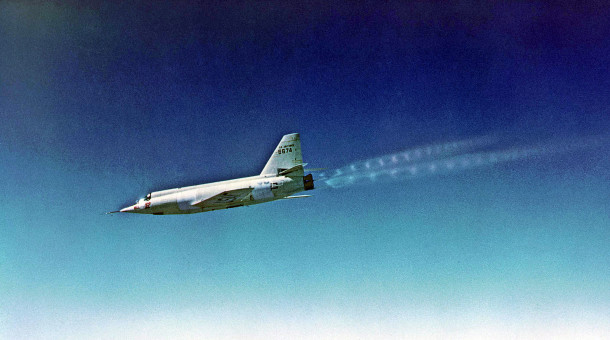
Fifty-nine years ago yesterday, the No. 1 USAF/Bell X-2 rocket-powered flight research aircraft reached a record speed of 2,094 mph with USAF Captain Milburn G. “Mel” Apt at the controls. However, victory quickly turned to tragedy when the aircraft departed controlled flight, crashed to destruction, and Apt perished.
Mel Apt’s historic achievement came about because of the Air Force’s desire to have the X-2 reach Mach 3 before turning it over to the National Advisory Committee For Aeronautics (NACA) for further flight research testing. Just 20 days prior to Apt’s flight in the X-2, USAF Captain Iven C. Kincheloe, Jr. had flown the aircraft to a record altitude of 126,200 feet.
On Thursday, 27 September 1956, Apt and the X-2 (Ship No. 1, S/N 46-674) dropped away from the USAF B-50 motherhip at 30,000 feet and 225 mph. Despite the fact that Mel Apt had never flown an X-aircraft, he executed the flight profile exactly as briefed. In addition, the X-2′s twin-chamber XLR-25 rocket motor burned propellant 12.5 seconds longer than planned. Both of these factors contributed to the aircraft attaining a speed in excess of 2,000 mph.
Apt and his aerial steed hit a peak Mach number of 3.2 at an altitude of 65,000 feet. Based on previous flight tests as well as flight simulator sessions, Apt knew that the X-2 had to slow to roughly Mach 2.4 before turning the aircraft back to Edwards. This was due to degraded directional stability, control reversal, and aerodynamic coupling issues that adversely affected the X-2 at higher Mach numbers.
However, Mel Apt was now faced with a difficult decision. If he waited for the X-2 to slow to Mach 2.4 before initiating a turn back to Edwards Air Force Base, he quite likely would not have enough energy and therefore range to reach Rogers Dry Lake. On the other hand, if he decided to initiate the turn back to Edwards at high Mach number, he risked having the X-2 depart controlled flight. Flying in a coffin corner of the X-2’s flight envelope, Apt opted for the latter.
As Apt increased the aircraft’s angle-of-attack, the X-2 departed controlled flight and subjected him to a brutal pounding. Aircraft lateral acceleration varied between +6 and -6 g’s. The battered pilot ultimately found himself in a subsonic, inverted spin at 40,000 feet. At this point, Apt effected pyrotechnic separation of the X-2′s forebody which contained the cockpit and a drogue parachute.
X-2 forebody separation was clean and the drogue parachute deployed properly. However, Apt still needed to bail out of the X-2′s forebody and deploy his personal parachute to complete the emergency egress process. However, it was not to be. Mel Apt ran out of time, altitude, and luck. The young pilot lost his life when the X-2 forebody from which he was trying to escape impacted the ground at a speed of one hundred and twenty miles an hour.
Mel Apt’s flight to Mach 3.2 established a record that stood until the X-15 exceeded it in August 1960. However, the price for doing so was very high. The USAF lost a brave test pilot and the lone remaining X-2 on that fateful day in September 1956. The mishap also ended the USAF X-2 Program. NACA never did conduct flight research with the X-2.
However, for a few terrifying moments, Mel Apt was the fastest man alive.
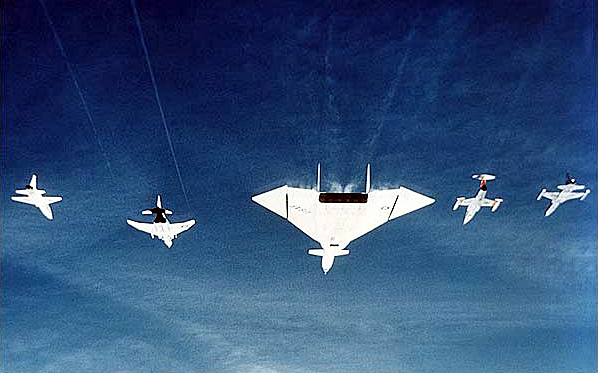
Forty-nine years ago today, XB-70A Valkyrie Air Vehicle No. 2 (62-0207) and a NASA F-104N Starfighter (N813NA) were destroyed following a midair collision near Bartsow, CA. USAF Major Carl S. Cross and NASA Chief Test Pilot Joseph A. Walker perished in the tragedy.
On Wednesday, 08 June 1966, XB-70A Valkyrie Air Vehicle No. 2 took-off from Edwards Air Force Base, California for the final time. The crew for this flight included aircraft commander and North American test pilot Alvin S. White and right-seater USAF Major Carl S. Cross. White would be making flight No. 67 in the XB-70A while Cross was making his first. For both men, this would be their final flight in the majestic Valkyrie.
In the past several months, Air Vehicle No. 2 had set speed (Mach 3.08) and altitude (74,000 feet) records for the type. But on this fateful day, the mission was a simple one; some minor flight research test points and a photo shoot.
The General Electric Company, manufacturer of the massive XB-70A’s YJ93-GE-3 turbojets, had received permission from Edwards USAF officials to photograph the XB-70A in close formation with a quartet of other aircraft powered by GE engines. The resulting photos were intended to be used for publicity.
The formation, consisting of the XB-70A, a T-38A Talon (59-1601), an F-4B Phantom II (BuNo 150993), an F-104N Starfighter (N813NA), and an F-5A Freedom Fighter (59-4898), was in position at 25,000 feet by 0845. The photographers for this event, flying in a GE-powered Gates Learjet Citation (N175FS) stationed about 600 feet to the left and slightly aft of the formation, began taking photos.
The photo session was planned to last 30 minutes, but went 10 minutes longer to 0925. Then at 0926, just as the formation aircraft were starting to leave the scene, the frantic cry of Midair! Midair Midair! came over the communications network.
Somehow, the NASA F-104N, piloted by NASA Chief Test Pilot Joe Walker, had collided with the right wing-tip of the XB-70A. Walker’s out-of-control F-104 then rolled inverted to the left and sheared-off the XB-70A’s twin vertical tails. The F-104N fuselage was severed just behind the cockpit and Walker died instantly in the terrifying process.
Curiously, the XB-70A continued on in steady, level flight for about 16 seconds despite the loss of its primary directional stability lifting surfaces. Then, as White attempted to control a roll transient, the XB-70A rapidly departed controlled flight.
As the doomed aircraft torturously pitched, yawed and rolled, its left wing structurally failed and fuel spewed furiously from its fuel tanks. White was somehow able to eject and survive. Cross never left the aircraft and rode it down to impact just north of Barstow, California.
A mishap investigation followed and (as always) blame was assigned and new procedures implemented. However, none of that changed the facts that on this, the Blackest Day at Edwards Air Force Base, American aviation lost two of its best men and aircraft in a flight mishap that was, in the final analysis, preventable.
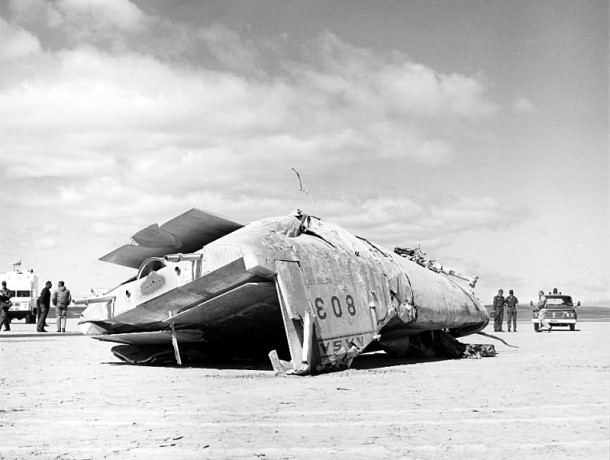
Forty-eight years ago this week, NASA’s experimental M2-F2 lifting body flight research aircraft was demolished in a horrific landing mishap on Rogers Dry Lake at Edwards Air Force Base. Although critically injured, NASA test pilot Bruce A. Peterson survived the mishap.
A lifting body is a wingless aircraft wherein the aerodynamic lift required for flight is derived solely from the fuselage. Interest in such a configuration stems from the type’s inherent suitability for lifting atmospheric entry from space. The primary attributes of same being favorable cross-range capability and aerodynamic heating performance.
Lifting body concepts date back to at least the 1950’s. From 1963 to 1975, both NASA and the United States Air Force conducted a number of manned lifting body flight research programs. The aircraft involved were the M2-F1, M2-F2, M2-F3, HL-10, X-24A and X-24B. All were flown out of Edwards Air Force Base between 1963 and 1975.
The favorable hypersonic flight performance of lifting bodies comes at a price. Specifically, lifting bodies are not particularly good subsonic aircraft from the standpoint of lateral-directional handling qualities. The type also falls like a rock in the approach and landing phase. Due to characteristically-low values of subsonic lift-to-drag ratio, touchdown speeds can exceed 250 knots.
The M2-F2 was the first of the heavy weight lifting bodies. It measured 22 feet in length and 9.4 feet in span. The aircraft had an empty weight of 4,630 pounds. The M2-F2 had boosted hydraulic 3-axis flight controls and a stability augmentation system. The vehicle was also configured with a quartet of hydrogen peroxide rockets rated at 400 pounds of thrust each.
On Wednesday, 10 May 1967, the M2-F2 (NASA S/N 803) fell away from the fabled B-52B (S/N 52-0008) launch aircraft at an altitude of 44,000 feet. NASA test pilot Bruce A. Peterson was at the controls of the M2-F2. This was Peterson’s 3rd flight in the M2-F2 and the aircraft’s 16th overall. It would be the last research flight for both man and machine.
The early part of the mission was unremarkable. Then the flight test gremlins made their presence known. Passing through 7,000 feet in a steep glide, Peterson pushed forward on the control column and brought the M2-F2 to quasi-zero angle-of-attack. The aircraft quickly entered a Dutch Roll which resulted in extreme, rapid lateral excusions.
Peterson increased angle-of-attack to arrest the wild lateral-directional motions of the M2-F2. However, he was no longer pointed toward Runway 18 on Rogers Dry Lake as intended. The ground was coming up rapidly and he would have to land the M2-F2 on a part of the lakebed that did not have the typical visual aids required for correctly judging height above surface level.
Peterson might have gotten himself and the M2-F2 on the ground in one piece except for the helicopter that now loomed directly ahead in his landing path. Not that it was the helicopter pilot’s fault. It was just that the M2-F2 had strayed so far from its intended flight path that the helicopter was suddenly a navigational hazard.
Managing to somehow avoid a collision with the flight support helicopter, Peterson now fired his landing rockets in an attempt to stay in the air a little longer. He then hit the landing gear switch. In 1.5 seconds the gear would be down and locked. Unfortunately for Peterson, there was only one second of flight time remaining before touchdown.
As the M2-F2 contacted the lakebed at 220 knots, its main landing gear was jammed back up into the fuselage. That was the end of the ball game. Sickeningly, the M2-F2 tumbled end-over-end across Rogers Dry Lake shearing off the canopy, main gear and right vertical tail. The battered and twisted airframe finally came to rest inverted on the ancient lakebed.
Incredibly, rescue crews found Bruce Peterson still alive as they came upon the crash scene. He was even conscious. However, the pilot was terribly hurt. Peterson’s oxygen mask had been torn off as the M2-F2 tumbled six (6) times before coming to a stop. He received severe facial injuries due to repeated impact with the lakebed surface. In addition, Peterson suffered a fractured skull, severe damage to his right eye and a broken hand.
Bruce Peterson came back from his brush with eternity. He needed extensive reconstructive surgery on his face and lost the sight in his right eye. Peterson served as a project engineer for a number of NASA flight programs and even flew as a Marine reservist. He later served as a safety officer on the B-2 flight test effort. Bruce Peterson passed away at the age of 72 on 01 May 2006.
For those who remember, “The Six-Million-Dollar Man” was a television series about a fictional test pilot who had been badly injured in an aircraft accident. In the storyline, the fictional character was “rebuilt” by doctors using bionic technology. Trivia buffs may be interested to know that the basis for “The Six-Million-Dollar Man” was Bruce Peterson’s M2-F2 experience.
For those that remember, the “The Six-Million-Dollar Man” was a televison series about a fictional test pilot who had been badly injured in an aircraft accident. In the storyline, the fictional character was “rebuilt” by doctors using bionic technology. Trivia buffs may be interested to know that the basis for “The Six-Million-Dollar Man” was Bruce Peterson’s terrifying M2-F2 crash.

Six years ago this month, US Airways Flight 1549 successfully ditched in the Hudson River following loss of thrust in both turbofan engines. Incredibly, all 155 passengers and crew members survived.
US Airways Flight 1549 lifted-off from Runway 4 of New York’s LaGuardia Airport at 18:25:56 UTC on Thursday, 15 January 2009. The Airbus 320-214 (N106US) was making its 16,299th flight. Call sign for the day’s flight was Cactus 1549.
Captain Chesley B. Sullenberger III and First Officer Jeffrey B. Skiles were in the cockpit of Cactus 1549. Donna Dent, Doreen Welsh and Sheila Dail served as flight attendants. Together, these crew members were responsible for the lives of 150 airline passengers.
Following a normal take-off, Cactus 1549 collided with a massive flock of Canadian Geese climbing through 3,000 feet. Numerous bird strikes were experienced. Most critically, both CFM56-5B4/P turbofan engines suffered bird ingestion. As Captain Sullenberger suscinctly described it later, the result was “sudden, complete, symmetrical” loss of thrust.
Quickly assessing their predicament, Captain Sullenberger instinctively knew that he could not get his aircraft back to a land-based runway. He was flying too low and slow to make such an attempt. He would have to ditch his 150,000-pound aircraft in the nearest waterway; the Hudson River.
The story of what ensued following loss of thrust is best told by Captain Sullenberger himself. The reader is therefore directed to chapters 13 and 14 of his post-mishap book entitled “Highest Duty”. The bottom line is that the aircraft was successfully ditched in the Hudson River roughly three and half minutes after loss of thrust in both engines.
Once the aircraft was on the water, the crew members evacuated all 150 passengers in less than 4 minutes. People either got into life rafts or stood on the aircraft’s wings. It was very cold. Air temperature was 21F with a windchill factor of 11F. The water temperature registered at 36F.
First responders from the New York Waterway quickly came to the aid of Cactus 1549. A total of fourteen vessels responded to the emergency with the first boat arriving within four minutes of the aircraft coming to a stop.
Many selfless acts of compassion and exemplary displays of valor were observed during Cactus 1549 rescue operations. This was true for those amongst the ranks of the rescuers and rescued alike.
Happily and to the great relief of the US Airways flight crew, there was no loss of life resulting from the emergency ditching of Cactus 1549. Now known as “The Miracle on the Hudson”, the events of that harrowing experience on a winter day in NYC will be forever remembered in the annals of aviation.
For their professional efforts in handling the Cactus 1549 in-flight emergency, Chesley Sullenberger, Jeff Skiles, Donna Dent, Doreen Welsh and Sheila Dail received the rarely-awarded Guild of Air Pilots and Air Navigators Master’s Medal on Thursday, 22 January 2009.
In part, the Master’s Medal citation read: “The reactions of all members of the crew, the split second decision making and the handling of this emergency and evacuation was ‘text book’ and an example to us all. To have safely executed this emergency ditching and evacuation, with the loss of no lives, is a heroic and unique aviation achievement.”
To which we say: Amen!
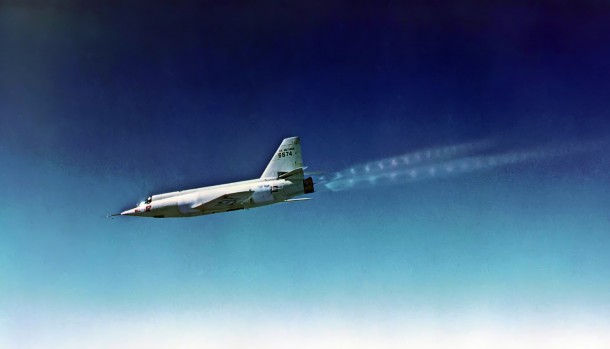
Fifty-eight years ago this week, the Bell X-2 rocket-powered research aircraft reached a record speed of 2,094 mph with USAF Captain Milburn G. “Mel” Apt at the controls. The new speed mark corresponded to a Mach number of 3.2 at an altitude of 65,000 feet.
Mel Apt’s historic achievement came about because of the Air Force’s desire to have the X-2 reach Mach 3 before turning it over to the National Advisory Committee For Aeronautics (NACA) for further flight research testing. Just 20 days prior to Apt’s flight in the X-2, USAF Captain Iven C. Kincheloe, Jr. had flown the aircraft to a record altitude of 126,200 feet.
On Thursday, 27 September 1956, Apt and the last X-2 aircraft (S/N 46-674) dropped away from the USAF B-50 motherhip at 30,000 feet and 225 mph. Despite the fact that Apt had never flown an X-aircraft, he executed the flight profile exactly as briefed. In addition, the X-2′s twin-chamber XLR-25 rocket motor burned propellant 12.5 seconds longer than planned. Both of these factors contributed to the aircraft attaining a speed in excess of 2,000 mph.
Based on previous flight tests as well as flight simulator sessions, Apt knew that the X-2 had to slow to roughly Mach 2.4 before turning the aircraft back to Edwards. This was due to degraded directional stability, control reversal, and aerodynamic coupling issues that adversely affected the X-2 at higher Mach numbers.
However, Mel Apt was now faced with a difficult decision. If he waited for the X-2 to slow to Mach 2.4 before initiating a turn back to Edwards Air Force Base, he quite likely would not have enough energy and therefore range to reach Rogers Dry Lake. On the other hand, if he decided to initiate the turn back to Edwards at high Mach number, he risked having the X-2 depart controlled flight. Flying in a coffin corner of the X-2’s flight envelope, Apt opted for the latter.
As Apt increased the aircraft’s angle-of-attack, the X-2 departed controlled flight and subjected him to a brutal pounding. Aircraft lateral acceleration varied between +6 and -6 g’s. The battered pilot ultimately found himself in a subsonic, inverted spin at 40,000 feet. At this point, Apt effected pyrotechnic separation of the X-2′s forebody which contained the cockpit and a drogue parachute.
X-2 forebody separation was clean and the drogue parachute deployed properly. However, Apt still needed to bail out of the X-2′s forebody and deploy his personal parachute to complete the emergency egress process. But, it was not to be. Mel Apt ran out of time, altitude, and luck. He lost his life when the X-2 forebody that he was trying to escape from impacted the ground at several hundred miles an hour.
Mel Apt’s flight to Mach 3.2 established a record that stood until the X-15 exceeded it in August 1960. However, the price for doing so was very high. The USAF lost a brave test pilot and the lone remaining X-2 on that fateful day in September 1956. The mishap also ended the USAF X-2 Program. NACA never did conduct flight research with the X-2.
However, for a few terrifying moments, Mel Apt was the fastest man alive.
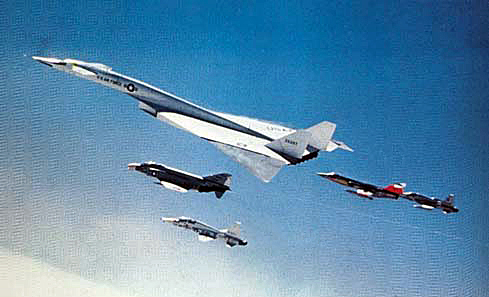
Forty-eight years ago this month, XB-70A Valkyrie Air Vehicle No. 2 (62-0207) took-off from Edwards Air Force Base, California for the final time.
The crew for this flight included aircraft commander and North American test pilot Alvin S. White and right-seater USAF Major Carl S. Cross. White would be making flight No. 67 in the XB-70A while Cross was making his first. For both men, this would be their final XB-70A flight.
In the past several months, Air Vehicle No. 2 had set speed (Mach 3.08) and altitude (74,000 feet) records for the type. But on this fateful Wednesday, 08 June 1966, the mission was a simple one; some run-of-the-mill flight research test points and a multi-aircraft formation photo shoot.
The General Electric Company, manufacturer of the massive XB-70A’s YJ93-GE-3 turbojets, had received permission from Edwards USAF officials to photograph the XB-70A in close formation with a quartet of other aircraft powered by GE engines. The resulting photos were intended to be used for publicity.
The formation, consisting of the XB-70A, a T-38A (59-1601), an F-4B (BuNo 150993), an F-104N (N813NA), and an F-5A (59-4898), was in position at 25,000 feet by 0845. The photographers for this event, flying in a GE-powered Gates Learjet (N175FS) stationed about 600 feet to the left and slightly aft of the multi-ship formation, began taking photos.
The photo session was planned to last 30 minutes, but went 10 minutes longer to 0925. Then at 0926, just as the formation aircraft were starting to leave the scene, the frantic cry of Midair! Midair Midair! came over the communications network.
Somehow, the NASA F-104N, piloted by NASA Chief Test Pilot Joe Walker, had collided with the right wing-tip of the XB-70A. Walker’s out-of-control F-104 then rolled inverted to the left and sheared-off the XB-70A’s twin vertical tails. The F-104N fuselage was severed just behind the cockpit and Walker was killed instantly in the process.
Curiously, the XB-70A continued on in steady, level flight for about 16 seconds despite the loss of its primary directional stability lifting surfaces. Then, as White attempted to control a roll transient, the XB-70A rapidly departed controlled flight.
As the doomed aircraft torturously pitched, yawed and rolled, its left wing structurally failed and fuel spewed furiously from its fuel tanks. White was somehow able to eject and survive. Cross never left the aircraft and rode it down to impact just north of Barstow, California.
A mishap investigation followed and (as always) blame was assigned. However, none of that changed the facts that on this, the Blackest Day at Edwards, American aviation lost two of its best men and aircraft in a flight mishap that never should have happened.
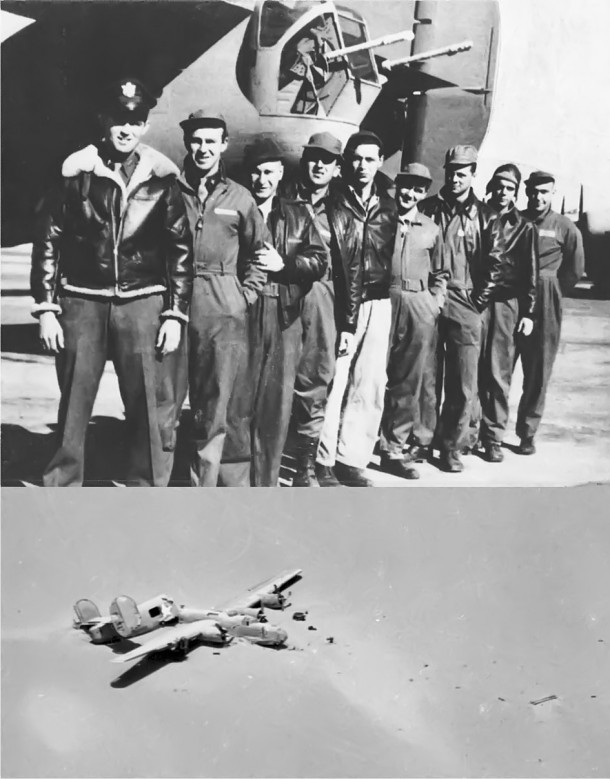
Seventy-one years ago this month, a USAAF/Consolidated B-24D Liberator and her crew vanished upon return from their first bombing mission over Italy. Known as the Lady Be Good, the hulk of the ill-fated aircraft was found sixteen years later lying deep in the Libyan desert more than 400 miles south of Benghazi.
The disappearance of the Lady Be Good and her young air crew is one of the most intriguing and haunting stories in the annals of aviation. Books and web sites abound which report what is now known about that doomed mission. Our purpose here is to briefly recount the Lady Be Good story.
The B-24D Liberator nicknamed Lady Be Good (S/N 41-24301) and her crew were assigned to the USAAF’s 376th Bomb Group, 9th Air Force operating out of North Africa. Plane and crew departed Soluch Army Air Field, Libya late in the afternoon of Sunday, 04 April 1943. The target was Naples, Italy some 700 miles distant.
Listed from left to right as they appear in the photo above, the crew who flew the Lady Be Good on the Naples raid were the following air force personnel:
1st Lt. William J. Hatton, pilot — Whitestone, New York
2nd Lt. Robert F. Toner, co-pilot — North Attleborough, Massachusetts
2nd Lt. D.P. Hays, navigator — Lee’s Summit, Missouri
2nd Lt. John S. Woravka, bombardier — Cleveland, Ohio
T/Sgt. Harold J. Ripslinger, flight engineer — Saginaw, Michigan
T/Sgt. Robert E. LaMotte, radio operator — Lake Linden, Michigan
S/Sgt. Guy E. Shelley, gunner — New Cumberland, Pennsylvania
S/Sgt. Vernon L. Moore, gunner — New Boston, Ohio
S/Sgt. Samuel E. Adams, gunner — Eureka, Illinois
The LBG was part of the second wave of twenty-five B-24 bombers assigned to the Naples raid. Things went sour right from the start as the aircraft took-off in a blinding sandstorm and became separated from the main bomber formation. Left with little recourse, the LBG flew alone to the target.
The Naples raid was less than successful and like most of the other aircraft that did make it to Italy, the LBG ultimately jettisoned her unused bomb load into the Mediterranean. The return flight to Libya was at night with no moon. All aircraft recovered safely with the exception of the Lady Be Good.
It appears that the LBG flew along the correct return heading back towards their Soluch air base. However, the crew failed to recognize when they were over the air field and continued deep into the Libyan desert for about 2 hours. Running low on fuel, pilot Hatton ordered his crew to jump into the dark night.
Thinking that they were still over water, the crewmen were surprised when they landed in sandy desert terrain. All survived the harrowing experience with the exception of bombardier Woravka who died on impact when his parachute failed. Amazingly, the LBG glided to a wings level landing 16 miles from the bailout point.
What happens next is a tale of tragic, but heroic proportions. Thinking that they were not far from Soluch, the eight surviving crewmen attempted to walk out of the desert. In actuality, they were more than 400 miles from Soluch with some of the most forbidding desert on the face of the earth between them and home. They never made it back.
The fate of the LBG and her crew would be an unsolved mystery until British oilmen conducting an aerial recon discovered the aircraft resting in the sandy waste on Sunday, 09 November 1958. However, it wasn’t until Tuesday, 26 May 1959 that USAF personnel visited the crash site. The aircraft, equipment, and crew personal effects were found to be remarkably well-preserved.
The saga about locating the remains of the LBG crew is incredible in its own right. Suffice it to say here that the remains of eight of the LBG crew members were recovered by late 1960. Subsequently, they were respectfully laid to rest with full military honors back in the United States. Despite herculean efforts, the body of Vernon Moore has never been found.
A pair of LBG crew members kept personal diaries about their ordeal in the Libyan desert; co-pilot Toner and flight engineer Ripslinger. These diaries make for sober reading as they poignantly document the slow and tortuous death of the LBG crew. To say that they endured appalling conditions is an understatement. The information the diaries contain suggests that all of the crewmen were dead by Tuesday, 13 April 1943.
Although they did not made it out of the desert, the LBG crewmen far exceeded the limits of human endurance as it was understood in the 1940’s. Five of the crew members traveled 78 miles from the parachute landing point before they succumbed to the ravages of heat, cold, dehydration, and starvation. Their remains were found together.
Desperate to secure help for their companions, Moore, Ripslinger and Shelley left the five at the point where they could no longer travel. Incredibly, Ripslinger’s remains were found 26 miles further on. Even more astounding, Shelley’s remains were discovered 37.5 miles from the group. Thus, the total distance that he walked was 115.5 miles from his parachute landing point in the desert.
We honor forever the memory of the Lady Be Good and her valiant crew. However, we humbly note that theirs is but one of the many cruel and ironic tragedies of war. To the LBG crew and the many other souls whose stories will never be told, may God grant them all eternal rest.
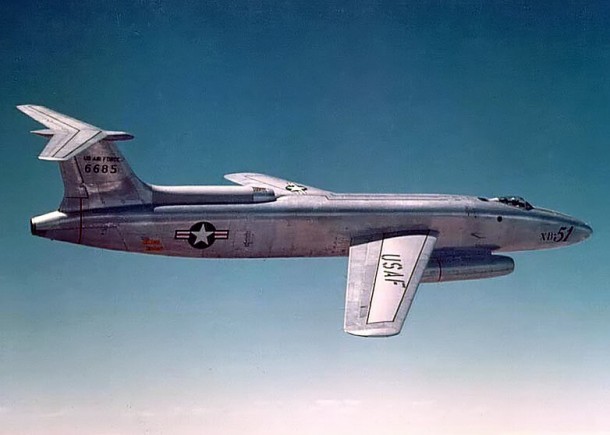
Fifty-eight years ago this month, the lone remaining USAF/Martin XB-51 light attack bomber prototype crashed during take-off from El Paso International Airport in Texas. The cause of the mishap was attributed to premature rotation of the aircraft leading to an unrecoverable stall.
A product of the post-WWII 1940’s, the Martin XB-51 was envisioned as a jet-powered replacement for the piston-driven Douglas A-26 Invader. The swept-wing XB-51 utilized a unique propulsion system which consisted of a trio of General Electric J47 turbojets. Demonstrated top speed was 560 knots at sea level.
The XB-51 was a good-sized airplane. With a length of 85 feet and a wing span of 53 feet, the XB-51 had a nominal take-off weight of around 56,000 lbs. The wings were swept 35 degrees aft and incorporated 6 degrees of anhedral. The latter feature to counter the large dihedral effect produced by the type’s tee-tail.
A pair of XB-51 aircraft were built by Martin for USAF. Ship No. 1 (S/N 46-0685) first took to the air in October of 1949 followed by the flight debut of Ship No. 2 (S/N 46-0686) in April of 1950. The air crew consisted of a pilot who sat underneath a large, clear canopy and a navigator housed within the fuselage.
While the XB-51 flew hundreds of hours in flight test and made many lasting contributions to the aviation field, the aircraft never went into production. This fate was primarily the result of having lost a head-to-head competitive fly-off against the English Electric Canberra B-57A light attack bomber in 1951.
The No. 1 XB-51 aircraft was lost on Sunday, 25 March 1956 during take-off from El Paso International Airport. The mishap aircraft accelerated more slowly than normal and with the end of the runway coming up quickly, the pilot rotated the aircraft in a attempt to get airborne. Unfortunately, the rotation was premature and the wing stalled. The aircraft exploded on impact and the crew of USAF Major James O. Rudolph and Staff-Sargent Wilbur R. Savage were killed.
The loss of the No. 1 XB-51 was preceded by the destruction of Ship No. 2 (S/N 46-0686) on Friday, 09 May 1952. That tragedy occurred during low-altitude aerobatic maneuvers at Edwards Air Force Base in California. The pilot, USAF Major Neil H. Lathrop, perished in the resulting post-impact explosion and inferno.
As a footnote, the XB-51 was never assigned an official nickname by the Air Force. However, it was unofficially referred to in some aviation circles as the Panther. Due to its prominently-long fuselage, the less majestic monicker of “Flying Cigar” was sometimes used as well.










